
The Rubik's Cube is a 3-D combination puzzle originally invented in 1974 by Hungarian sculptor and professor of architecture Ernő Rubik. Originally called the Magic Cube, the puzzle was licensed by Rubik to be sold by Ideal Toy Corp in 1980 via businessman Tibor Laczi and Seven Towns founder Tom Kremer. The cube was released internationally in 1980 and became one of the most recognized icons in popular culture. It won the 1980 German Game of the Year special award for Best Puzzle. As of January 2009, 350 million cubes had been sold worldwide, making it the world's bestselling puzzle game and bestselling toy.

Ernő Rubik is a Hungarian inventor, architect and professor of architecture. He is best known for the invention of mechanical puzzles including the Rubik's Cube (1974), Rubik's Magic, Rubik's Magic: Master Edition, and Rubik's Snake.

Yoshiro Nakamatsu, also known as Dr. NakaMats, is a Japanese inventor. He regularly appears on Japanese talk shows demonstrating his inventions.

The Pocket Cube is the 2×2×2 equivalent of a Rubik's Cube. The cube consists of 8 pieces, all corners.
Speedcubing is a game involving solving a variety of combination puzzles, the most famous being the 3x3x3 puzzle or Rubik's Cube, as quickly as possible. For most puzzles, solving involves performing a series of moves that alters a scrambled puzzle into a solved state, in which every face of the puzzle is a single, solid color. Some puzzles have different requirements to be considered solved, such as the Clock, for which all the dials must be moved to the 12 'o clock position. The standard cubic puzzle sizes are 2x2x2, 3x3x3, 4x4x4, 5x5x5, 6x6x6, and 7x7x7 and the different variations of speed solving, 3x3x3 one handed, 3x3x3 blindfolded, 4x4x4 blindfolded and 5x5x5 blindfolded. There are also different shapes of the famous puzzles, including Pyraminx, Megaminx, Skewb and Square-1. An individual who practices solving twisty puzzles is known as a speedcuber, or a cuber.

The Professor's Cube is a 3-D combination puzzle, a 5×5×5 version of the original Rubik's Cube. It has qualities in common with both the 3×3×3 Rubik's Cube and the 4×4×4 Rubik's Revenge, and solution strategies for both can be applied the Professor's Cube.

The Pyraminx is a regular tetrahedron puzzle in the style of Rubik's Cube. It was made and patented by Uwe Mèffert after the original 3 layered Rubik's Cube by Ernő Rubik, and introduced by Tomy Toys of Japan in 1981.
Yoshiki Okamoto, sometimes credited as Kihaji Okamoto, is a Japanese video game designer. He is credited with producing popular titles for Konami, including Gyruss and Time Pilot, and for Capcom, including 1942, Gun.Smoke, Final Fight and Street Fighter II. He later founded the companies Flagship and Game Republic, and then created the hit mobile games Dragon Hunter and Monster Strike for Mixi. He also played a role in the creation of Rockstar's Red Dead franchise. Several franchises he helped create are among the highest-grossing video game franchises of all time, including Street Fighter II, Monster Strike and Red Dead.

Sudoku is a logic-based, combinatorial number-placement puzzle. In classic Sudoku, the objective is to fill a 9 × 9 grid with digits so that each column, each row, and each of the nine 3 × 3 subgrids that compose the grid contain all of the digits from 1 to 9. The puzzle setter provides a partially completed grid, which for a well-posed puzzle has a single solution.

Resident Evil – Code: Veronica is a survival horror video game developed and published by Capcom and originally released for the Dreamcast in 2000. It is the fourth main installment in the Resident Evil series and the first to debut on a separate platform from the PlayStation. The story takes place three months after the events of Resident Evil 2 (1998) and the concurrent destruction of Raccoon City as seen in Resident Evil 3: Nemesis (1999). It follows Claire Redfield and her brother Chris Redfield in their efforts to survive a viral outbreak at a remote prison island in the Southern Ocean and a research facility in Antarctica. The game retains the traditional survival horror controls and gameplay of previous installments; however, unlike the pre-rendered backgrounds of previous games, Code: Veronica uses real-time 3D environments and dynamic camera movement.

The World Cube Association (WCA) is the worldwide non-profit organization that regulates and holds competitions for mechanical puzzles that are operated by twisting groups of pieces, commonly known as twisty puzzles. The most famous of those puzzles is the Rubik's Cube. The WCA was founded by Ron van Bruchem of the Netherlands and Tyson Mao of the United States in 2004. The goal of the World Cube Association is to have "more competitions in more countries with more people and more fun, under fair conditions." In 2017, they started work to become a non-profit organization and on November 20, 2017, the state of California accepted the initial registration of the World Cube Association.

A combination puzzle, also known as a sequential move puzzle, is a puzzle which consists of a set of pieces which can be manipulated into different combinations by a group of operations. Many such puzzles are mechanical puzzles of polyhedral shape, consisting of multiple layers of pieces along each axis which can rotate independently of each other. Collectively known as twisty puzzles, the archetype of this kind of puzzle is the Rubik's Cube. Each rotating side is usually marked with different colours, intended to be scrambled, then 'solved' by a sequence of moves that sort the facets by colour. As a generalisation, combination puzzles also include mathematically defined examples that have not been, or are impossible to, physically construct.

The Rubik's Cube, a 1974 invention of Ernő Rubik of Hungary, fascinated people around the globe and became one of the most popular games in America in the early 1980s, having been initially released as the Magic Cube in Hungary in late 1977, and then re-manufactured and released in the western world as Rubik's Cube in 1980. As of January 2009, 350 million cubes have been sold worldwide making it the world's top-selling puzzle game. It earned a place as a permanent exhibit in New York’s Museum of Modern Art and entered the Oxford English Dictionary in 1982. The Cube retains a dedicated following, with almost 40,000 entries on YouTube featuring tutorials and video clips of quick solutions.

The Void Cube is a 3-D mechanical puzzle similar to a Rubik's Cube, with the notable difference being that the center pieces are missing, which causes the puzzle to resemble a level 1 Menger sponge. The core used on the Rubik's Cube is also absent, creating holes straight through the cube on all three axes. Due to the restricted volume of the puzzle it employs an entirely different structural mechanism from a regular Rubik's Cube, though the possible moves are the same. The Void Cube was invented by Katsuhiko Okamoto. Gentosha Education, in Japan, holds the license to manufacture official Void Cubes. These official designs are also sold under the Rubik's brand, owned by Spin Master Ltd., and workalikes are available from a variety of manufacturers. Speed-solving the Void Cube is common in exhibition but is not an official World Cube Association competition event.

Feliks Aleksanders Zemdegs is an Australian Rubik's Cube speedsolver. He is the only speedcuber ever to win the World Cube Association World Championship twice, winning in 2013 and 2015, and is widely considered the most successful and the greatest speedcuber of all time. He has set more than 350 records across various speedcubing events: 121 world records, 210 continental records, and 6 national records.

The Helicopter Cube is a Rubik's Cube-like puzzle invented by Adam G. Cowan in 2005 and built in 2006. It is also in the shape of a cube. At first glance, the Helicopter Cube may seem like a combination of the 2x2x2 and the Skewb, but it actually cuts differently, and twists around cube edges rather than cube faces. The purpose of the puzzle is to scramble the colors, and then restore them back to their original state of a single color per face.
Panagiotis Verdes is a Greek inventor and is known for being the first person to mass produce 6x6x6 puzzles and 7x7x7 twisty puzzles. He is also known for founding the company V-Cube. He has also worked on new designs of every Twisty Puzzle from 2x2x2 to 11x11x11.

Tony Fisher is a British puzzle designer who specialises in creating custom rotational puzzles. He is acknowledged by cubing enthusiasts as a pioneer in the creation of new puzzle designs and new manufacturing techniques. In 2017 the Guinness Book of World Records acknowledged Fisher as the creator of the world's largest Rubik's cube.

Oskar van Deventer is a Dutch puzzle maker. He prototypes puzzles using 3D printing. His work combines mathematics, physics, and design, and he collaborates at academic institutions. Many of his combination puzzles are in mass production by Uwe Mèffert and WitEden. Oskar van Deventer has also designed puzzles for Hanayama.

Larry D. Nichols, born 1939 in the United States, is a puzzle designer. He grew up in Xenia, Ohio, and studied chemistry at DePauw University in Greencastle, Indiana, before moving to Massachusetts to attend Harvard Graduate School. He is best known for the invention of mechanical puzzles including 'The Nichols Cube Puzzle' (1974), patent US365520. He has lived with his wife Karen in Arlington, Massachusetts since 1959.

















